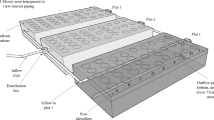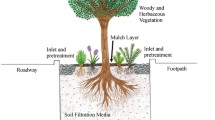Abstract
Filter media recommendations in stormwater bioremediation contain large ratios of sand. Ratios exceeding 75% by volume are supported by research into infiltration rates, physical filtration, reduced clogging, and leaching of nutrients from organics, satisfying engineering specifications. Perhaps, high sand ratios are causing hostile soil ecosystems for a majority of common ornamental landscape plants which are not adapted to such sandy soils. Most sands have lower cation exchange capacities and lower adhesion holding plant available moisture than clay fractions. Clay, however, is not an ideal component in stormwater management due to small physical size and tendency to clog filters causing failure of engineered functions. A number of studies have addressed this issue by seeking plants that are suited to high sand content (thus adapted to low fertility and low plant available moisture). While these studies may provide plants suitable to such gardens, they may not address the need for gardens to appeal esthetically to the general public and remain familiar to the maintenance crews which must service these systems. By highlighting possible shortfalls of high sand content soil blends, this review exposes a need for research in plant performance as well as soil micro- and macro-faunal communities within bioremediation by addressing the whole ecosystem. The filter and planting media used in stormwater management gardens should improve floral and faunal health while maintaining engineered specifications and esthetic requirements. With improved ecosystem health and activity, these gardens could last longer, perform better, and cost less to maintain.

Similar content being viewed by others
References
Askarizadeh, A., Rippy, M. A., Fletcher, T. D., Feldman, D., Peng, J., Bowler, P., et al. (2015). From rain tanks to catchments: use of low impact development to address hydrologic symptoms of the urban stream syndrome. Environmental Science & Technology, 49(19), 11264–11280. doi:10.1021/ACS.EST.5B01635.
Asleson, B. C., Gulliver, J. S., Hozalski, R. M., Nestingen, R. S., & Nieber, J. L. (2009, August). Performance assessment of rain gardens. Journal of the American Water Resources Association, 45(4), 1019–1031. doi:10.1111/j.1752-1688.2009.00344.x.
ASTM International (2015). ASTM D2487–11, standard practice for classification of soils for engineering purposes (unified soil classification system). West Conshohocken: ASTM International.
Bratieres, K., Fletcher, T. D., Deletic, A., & Zinger, Y. (2008). Nutrient and sediment removal by stormwater biofilters: a large scale design optimization study. Water Reserach, 42, 3930–3940.
Brix, H., Arias, C., & del Bubba, M. (2001). Media selection for sustainable phosphorus removal in subsurface flow constructed wetlands. Water Science and Technology, 44(11–12), 47–54.
Chow, V. T., Maidment, D. R., & Mays, L. W. (1988). Applied hydrology (1st ed.). New York: McGraw-Hill.
Christianson, R., Barfield, B., Hayes, J., Gasem, K., & Brown, G. (2004). Modeling effectiveness of bioretention cells for control of stormwater quantity and quality. Critical Transistions in Water and Enviornmental Resources Managment, 37, 1–7. doi:10.1061/40737.
Cooperative Research Centre for Water Sensitive Cities (2017) Retrieved from https://watersensitivecities.org.au. Accessed 1 June 2017.
Dayton, E. A., & Basta, N. T. (2005). Use of drinking water treatment residuals as a potential best management practice to reduce phosphorus risk index scores. Journal of Environmental Quality, 34(6), 2112–2117. doi:10.2134/jeq2005.0083.
Dietz, M. E. (2007). Low impact development practices: a review of current research and recommendations for future directions. Water, Air, and Soil Polution, 186, 351–363. doi:10.1007/s11270-007-9484-z.
Dietz, M., & Clausen, J. (2005). A field evaluation of rain garden flow and pollutant treatment. Water, Air, and Soil Pollution, 1(4), 123–138.
Donovan, T., Lowndes, M., McBrien, P., & Pfender, J. (2015). The Wisconsin storm water manual, technical design guidelines for storm water management practices. Wisconsin: Wisconsin Department of Natural Resources.
Dussaillant, A., Wu, C., & Potter, K. (2004). Richards equation model of a rain garden. Journal of Hydrologic Engineering, 9(3), 219–225.
FAWB (2009). Adoption guidelines for Stormwater biofiltration systems. Clayton: Facility for Advancing Water Biofiltration. Monash University.
Forbes, M. G., Dickson, K. L., Saleh, F., Doyle, R. D., & Hudak, P. (2005a). Recovery and fractionation of phosphorus retained by lightweight expanded shale and masonry sand used as media in subsurface flow treatment wetlands. Environmental Science and Technology, 39(12), 4621–4627. doi:10.1021/es048149o.
Forbes, M. G., Dickson, K. L., Saleh, F., & Waller, W. T. (2005b). Recovery and fractionation of phosphorus retained by lightweight expanded shale and masonry sand used as media in subsurface flow treatment wetlands. Environmental Science and Technology, 39(12), 4621–4627. doi:10.1021/es048149o.
Good, J. E., O'Sullivan, A. D., Wicke, D., & Cochrane, T. A. (2014). pH buffering in stormwater infiltration systems—sustainable contaminant removal with waste mussel shells. Water, Air, & Soil Polution, 225(1885), 1–11. doi:10.1007/s11270-014-1885-1.
Grimm, N. B., Grove, J. M., Pickett, S. T., & Redman, C. L. (2000). Integrated approaches to long-term studies of urban ecological systems. Bio-Science, 50(7), 571–584.
Hatt, B. E., Fletcher, T. D., & Deletic, A. (2008). Hydraulic and pollutant removal performance of fine media stormwater filtration systems. Environmental Science and Technology, 42(7), 2535–2541. doi:10.1021/es071264p.
Hauser, J., Curtis, J., Johnston, J., Dipen, P., & Keisler, M. (2005). Small-scale pilot testing of stormwater treatment systems to meet numerical effluent limits in the Lake Tahoe Basin. Alexandria: Water Environment Federation.
Hinsinger, P., Bengouga, A., Vetterlein, D., & Young, I. (2009). Rhizosphere: biophysics, biogeochemistry, and ecological relevance. Plant Soil Journal, 321, 117–152.
Holm, T. A., & Ries, J. P. (2007). Reference manual for the properties and applications of expanded shale, clay and slate lightweight aggregate. Salt Lake City: Expanded Shale, Clay & Slate Institute.
Holsten, A., Vetter, T., Vohland, K., & Krysanova, V. (2009, September 10). Impact of climate change on soil moisture dynamics in Brandenburg with a focus on nature conservation areas. Ecological Modelling, 220(17), 2076–2087.
Hunt, W. F., & Lord, W. G. (2006). Bioretention performance, design, construction, and maintenance. Raleigh: Cooperative Extension. North Carolina State University.
Hunt, W. F., & White, N. (2001). Designing rain gardens Ag-588-03. North Carolina State University, Department of Biological and Agricultural Engineering. North Carolina Cooperative Extension Service.
Hurley, S., Shrestha, P., & Cording, A. (2017, August). Nutrient leaching from compost: implications for bioretention and other green stormwater infrastructure. Journal of Sustainable Water in the Built Environment, 3(3). doi:10.1061/JSWBAY.0000821.
Kaplan, R., & Kaplan, S. (1989). The experience of nature: a psychological perspective. Cambridge: Cambridge University Press.
Liu, R., & Coffman, R. (2016). Lightweight aggregate made from dredged material in green roof construction for stormwater management. Materials, 9(8), 611. doi:10.3390/ma9080611.
Maryland Department of the Environment. (2009). Maryland stormwater design manual. Baltimore: Maryland Department of the Environment.
MDE (2009). Maryland Stormwater design manual volumes I and II. Baltimore: State of Maryland, Department of the Environment.
Mehring, A. S., & Levin, L. A. (2015a). REVIEW: potential roles of soil fauna in improving the efficiency of rain gardens. Journal of Applied Ecology, 52(6), 1445–1454. doi:10.1111/1365-2664.12525.
Mehring, A., & Levin, A. (2015b). REVIEW: Potential roles of soil fauna in improving the efficiency of rain gardens used as natural stormwater treatments systems. Journal of Applied Ecology, 52(6), 1445–1454. doi:10.1111/1365-2664.12525.
Mehring, A. S., Hatt, B. E., Kraikittikun, D., Orelo, B. D., Rippy, M. A., Grant, S. B., et al. (2016). Soil invertebrates in Australian rain gardens and their potential roles in storage and processing of nitrogen. Ecological Engineering, 97, 138–143. doi:10.1016/J.ECOLENG.2016.09.005.
Minnesota Pollution Control Agency. (2015). Minnesota stormwater manual. St. Paul: Minnesota Pollution Control Agency.
ODNR (2014). Rainwater and land development: Ohio’s standards for stormwater management, land development, and urban stream protection. Columbus: Divsion of Soil and Water Conservation. Ohio Department of Natural Resources.
Passioura, J. (1991). Soil structure and plant growth. Austrailian Journal of Soil Research, 29, 717–728. doi:10.1071/SR9910717.
Payne, E. G., Pham, T., Cook, P. L., Fletcher, T. D., Hatt, B. E., & Deletic, A. (2014). Biofilter design for effective nitrogen removal from stormwater—influence of plant species, inflow hydrology and use of a saturated zone. Water Science and Technology, 69, 1312–1319.
Payne, E., Hatt, B., Deletic, A., Dobbie, M., McCarthy, D., & Chandrasena, G. (2015). Adoption guidelines for stormwater biofiltration systems—Summary report. Melbourne: Cooperative Research Centre for Water Sensitive Cities.
Prince George's County. (1999). Low-impact development design stratagies: an integrated design approach. Department of Environmental Resources, Prince George's County, MD.
Prince George's County. (2014). Stormwater management design manual. Department of Permitting, Inspections and Enforcement, Prince George's County, MD.
RCWD (2017). Raingarden sample specifications . Minnesota Board of Soil and Water Resources, Rice Creek Watershed Distrtict. www.ricecreek.org.
Read, J., Wevill, T., Fletcher, T. D., & Deletic, A. (2008). Variation amoung plant speices in pollutant removal from stormwater in biofiltration systems. Water Research, 42, 893–902.
Read, J., Fletcher, T. D., Wevill, T., & Deletic, A. (2009). Plant traits that enhance pollutant removal from stormwater in biofiltration systems. International Journal of Phytoremediation, 12(1), 34–53.
Trowsdale, S., & Simcock, R. (2011). Urban stormwater treatment using bioretention. Journal of Hydrology, 397, 167–174.
Walsh, C. J., Roy, A. H., Feminella, J. W., Cottingham, P. D., Groffman, P. M., & Morgan, R. P. (2005). The urban stream syndrome: current knowledge and the search for a cure. Journal of the North American Benthological Society, 24(3), 706–723. doi:10.1899/0887-3593(2005)024[0706:TUSSCK]2.0.CO;2.
Walsh, C. J., Fletcher, T. D., & Burns, M. J. (2012). Urban storm water runoff: a new class of environmental flow problem. PloS One, 7(9), e45814.
Weil, R. R., & Brady, N. C. (2017). The nature and properites of soils, (15th ed.). London: Pearson.
Wentworth, C. K. (1922). A scale of grade and class terms for clastic sediments. The Journal of Geology, 30(5), 377–392 http://www.jstor.org/stable/30063207.
Author information
Authors and Affiliations
Corresponding author
Rights and permissions
About this article
Cite this article
Funai, J.T., Kupec, P. Exploring Planting and Filter Media in Stormwater Bioremediating Landscapes: a Review. Water Air Soil Pollut 228, 340 (2017). https://doi.org/10.1007/s11270-017-3524-0
Received:
Accepted:
Published:
DOI: https://doi.org/10.1007/s11270-017-3524-0




